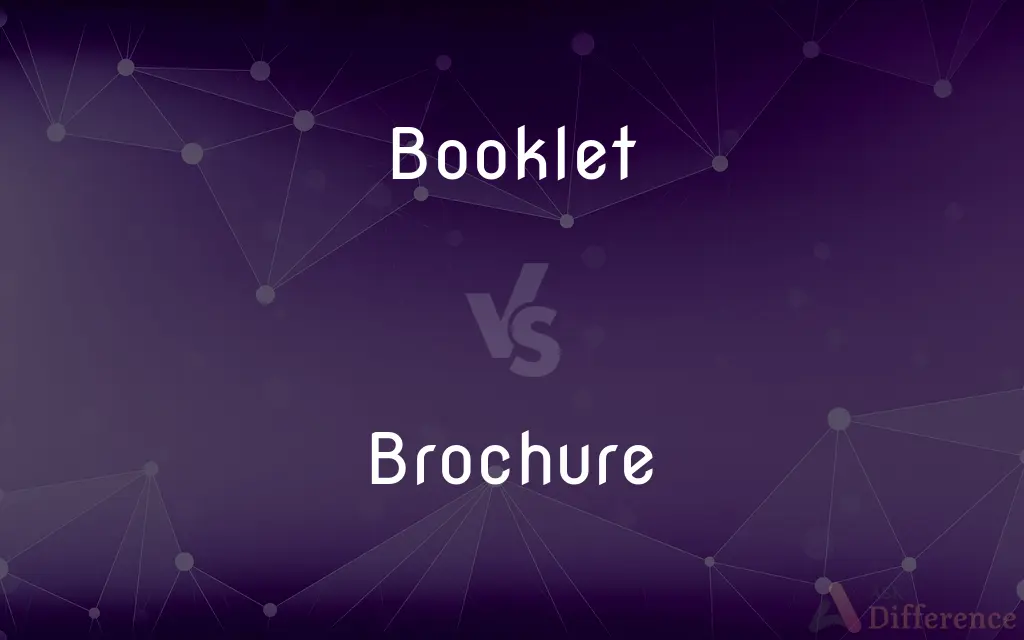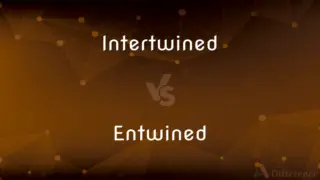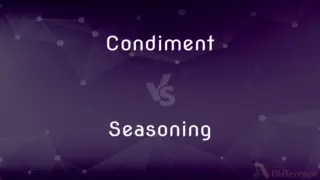Booklet vs. Brochure — What's the Difference?
By Fiza Rafique & Urooj Arif — Updated on March 29, 2024
A booklet is a small book with a few pages, often bound, used for information or advertising. A brochure is a single or multi-folded sheet used for marketing purposes, showcasing products or services.

Difference Between Booklet and Brochure
Table of Contents
ADVERTISEMENT
Key Differences
Booklets serve as informational or advertising tools but are distinct from brochures in their format and content depth. They typically contain more detailed information about a subject, product, or service, often featuring several pages that are bound together. This format is suitable for user manuals, catalogs, and event programs. On the other hand, brochures are designed to grab attention quickly, using engaging visuals and concise text to highlight key points about a product, service, or event, often folding into multiple sections for easy handling and distribution.
While both booklets and brochures are used in marketing and information dissemination, the choice between them depends on the amount of information to be conveyed and the desired impact on the target audience. Booklets, with their multiple pages, allow for a more comprehensive exploration of a topic, making them ideal for situations where depth and detail are important. Brochures, with their compact and easily navigable format, are perfect for highlighting the most attractive features of an offering, making a quick and strong impression.
The design elements of booklets and brochures also differ significantly. Booklets might include detailed descriptions, various types of imagery, and more extensive layouts due to their larger size and structure. Brochures, however, prioritize succinct messaging and eye-catching designs to convey information quickly and effectively in a limited space.
From a production standpoint, booklets require more complex binding methods, such as stapling or perfect binding, to hold the pages together, reflecting a higher production cost. Brochures, being simpler in their construction and typically requiring just a single sheet of paper, are less expensive to produce and can be distributed widely with less concern for the cost.
In terms of distribution and usage, booklets are often intended for readers with a vested interest in the topic, who are likely to invest time in reading through the material. Brochures, due to their brevity and visual appeal, are suited for broad distribution in places like trade shows, tourist centers, or as mail inserts, where quick consumption of information is the goal.
ADVERTISEMENT
Comparison Chart
Format
Small book with multiple pages, often bound
Single or multi-folded sheet
Content
Detailed information, more text
Concise text, engaging visuals
Purpose
In-depth exploration of a topic
Quick, attractive presentation of highlights
Design
Extensive layouts, various imagery
Succinct messaging, eye-catching design
Production
Requires binding, higher cost
Simpler, cost-effective
Distribution
Targeted audience, readers interested in detail
Broad distribution, quick consumption
Compare with Definitions
Booklet
Often used for catalogs and manuals.
The product catalog booklet includes detailed descriptions of each item.
Brochure
Can be single or multi-folded for easy handling.
The travel brochure unfolded to reveal various tour options.
Booklet
A small bound book for detailed information.
The event program was printed as a colorful booklet.
Brochure
A folded sheet used for marketing purposes.
Tourist attractions often distribute brochures with maps and highlights.
Booklet
Features multiple pages and sections.
The health information booklet contains several sections on wellness practices.
Brochure
Designed to be visually engaging and concise.
The new product brochure featured bold images and bullet points.
Booklet
Allows for comprehensive coverage of topics.
The company’s history was chronicled in a commemorative booklet.
Brochure
Ideal for quick highlights and overviews.
The event brochure provided a succinct overview of the schedule.
Booklet
Targeted towards an audience seeking depth.
Visitors received a booklet detailing the museum’s exhibits.
Brochure
Used for broad distribution to capture interest.
The company mailed out brochures to potential customers.
Booklet
A small, thin book with paper covers, typically giving information on a particular subject.
Brochure
A brochure is an informative paper document (often also used for advertising) that can be folded into a template, pamphlet, or leaflet. A brochure can also be a set of related unfolded papers put into a pocket folder or packet.
Booklet
A small bound book or pamphlet, usually having a paper cover.
Brochure
A small booklet or pamphlet, often containing promotional material or product information.
Booklet
A small or thin book.
Brochure
A booklet of printed informational matter, like a pamphlet, often for promotional purposes.
Have a look in the Vans brochure for a new vacuum cleaner
Booklet
A little book.
Brochure
A printed and stitched book containing only a few leaves; a pamphlet; a single sheet folded to make four pages.
Booklet
A small book usually having a paper cover
Brochure
A small book usually having a paper cover
Common Curiosities
Can brochures be used as effective marketing tools?
Yes, their visual appeal and concise format make them excellent for capturing immediate interest and conveying key highlights.
What is the main difference between a booklet and a brochure?
Booklets are small bound books with detailed information, while brochures are folded sheets designed for quick consumption.
When should I use a booklet instead of a brochure?
Use a booklet when you need to provide detailed information or comprehensive coverage on a topic.
What makes a brochure visually engaging?
High-quality images, bold colors, and strategic use of space to highlight key points.
Are booklets more expensive to produce than brochures?
Generally, yes, due to their binding and the amount of printed material involved.
How do the purposes of booklets and brochures overlap?
Both aim to inform or advertise, but differ in depth and method of presentation.
What binding methods are used for booklets?
Common methods include stapling, spiral binding, and perfect binding.
Can booklets be used for advertising?
Yes, especially for products or services requiring more thorough explanation or for a targeted audience.
How do you decide on the format between a booklet and a brochure?
Consider your content’s depth, audience’s information needs, distribution method, and budget.
How do design considerations differ between booklets and brochures?
Booklets allow for more extensive layouts and content, while brochures focus on succinct messaging and visual engagement.
Why might a company choose to distribute brochures?
For broad outreach, especially in situations where engaging potential customers quickly is crucial, like trade shows.
What are common uses for brochures?
Advertising, tourist information, event summaries, and product highlights.
Can digital versions of booklets and brochures be effective?
Yes, digital versions can reach a wider audience online and are cost-effective.
Do brochures or booklets have a higher engagement rate?
It depends on the audience and context; brochures for quick engagement and booklets for in-depth reading.
How long should a typical booklet be?
Length varies based on purpose but generally ranges from a few pages to dozens, depending on the content’s complexity.
Share Your Discovery

Previous Comparison
Intertwined vs. Entwined
Next Comparison
Condiment vs. SeasoningAuthor Spotlight
Written by
Fiza RafiqueFiza Rafique is a skilled content writer at AskDifference.com, where she meticulously refines and enhances written pieces. Drawing from her vast editorial expertise, Fiza ensures clarity, accuracy, and precision in every article. Passionate about language, she continually seeks to elevate the quality of content for readers worldwide.
Co-written by
Urooj ArifUrooj is a skilled content writer at Ask Difference, known for her exceptional ability to simplify complex topics into engaging and informative content. With a passion for research and a flair for clear, concise writing, she consistently delivers articles that resonate with our diverse audience.














































